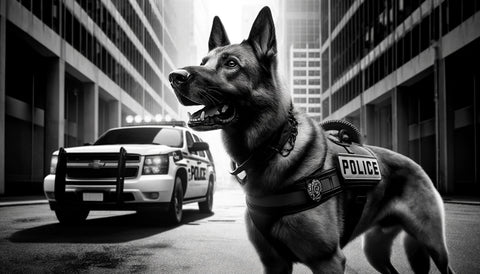The evolving legal landscape surrounding cannabis in the United States has brought about significant changes in various sectors, not least within law enforcement. Among the most affected are police canine units, which have traditionally played a role in drug detection efforts. These canine cops, trained to sniff out narcotics including cannabis, are facing early retirement or reassignment as more states legalize the use of cannabis. This blog explores the profound effects of these legal changes on police dogs and their handlers, examining both the historical context and the future direction of canine units in law enforcement.
The Role of Canine Cops in Drug Detection

Canine units have been integral to law enforcement strategies for decades, notably in the detection of drugs. Trained to identify various substances through scent, these dogs have been especially pivotal in locating hidden caches of illegal drugs, including cannabis. The training involves exposing the dogs to different narcotics and teaching them to signal the find in a specific way, usually by sitting or pawing at the location.
Police dogs are highly effective in their roles due to their acute sense of smell, which is significantly sharper than that of humans. This biological advantage allows them to detect minute traces of substances, making them invaluable at security checkpoints, border entries, and in police raids. However, their ability to detect cannabis — once an asset in the war on drugs — has become problematic with the shift in legal attitudes towards the substance.
The effectiveness of canine cops in detecting cannabis has a storied history. For instance, during their early introduction in drug enforcement, these dogs played a crucial role in curbing drug trafficking. Historical data from law enforcement agencies shows that canine units have been responsible for numerous arrests and seizures related to cannabis. Yet, the reliability of these dogs has also been a subject of debate, as indicated by various studies and reports. For example, a report from New South Wales noted that drugs were found in only 26% of searches initiated by drug detection dogs, with most findings being small amounts of cannabis intended for personal use.
These statistics highlight a critical issue: while effective in locating drugs, the broad application of canine capabilities without specific targeting can lead to a high incidence of false positives and minor drug finds that may not justify the extensive use of police resources. This becomes even more problematic in regions where cannabis has been legalized, as the detection of a now-legal substance could lead to unjustified searches, raising both ethical and legal concerns.
In the next section, we will delve into how the legalization of cannabis has necessitated significant changes in the deployment and training of police canine units, underscoring a major shift in law enforcement tactics in response to evolving drug laws.
Stay tuned for an exploration of the impact of these changes and the transition strategies being employed by law enforcement agencies across the country.
Impact of Cannabis Legalization

The sweeping legalization of cannabis across various U.S. states has triggered a reevaluation of the use of canine units in drug detection. As state laws increasingly acknowledge cannabis as a legal substance, the traditional role of drug-sniffing dogs, trained to alert on cannabis, has come under scrutiny. The problem arises from the dogs' training to alert to drugs indiscriminately, which now includes legal amounts of cannabis. This situation presents a legal conundrum: alerts from dogs can no longer be presumed to indicate illegal activity, potentially invalidating searches that were once routine under probable cause.
For instance, in Virginia, changes in cannabis legislation prompted a significant shift in law enforcement practices. Prior to legalization, cannabis detection was a key function of police dogs. Post-legalization, many of these dogs had to be retired prematurely because they could no longer be used to establish probable cause for searches. This is because they could not differentiate between legal possession amounts and amounts indicative of illegal activities. This pattern has been repeated in several other states, indicating a widespread impact on police operations and canine units.
The transition has not been seamless. In states like Minnesota, police dogs like Jango and Cobra, trained extensively in narcotics detection, faced early retirement or reassignment. The adjustments involve either transitioning these dogs to other roles that do not involve drug detection or outright retirement, which, while humane for the animal, poses logistical and emotional challenges for their handlers and the departments they serve.
Challenges and Considerations
Retraining police dogs to ignore cannabis while detecting other illegal drugs is not feasible due to the way scent detection training works. Once a behavior is trained, especially with scent detection, it is ingrained and cannot be untrained or reversed. This has led many law enforcement agencies to face the tough decision of retiring a significant portion of their canine workforce. The cost implications are considerable, as each new dog trained and brought into the force can cost upwards of $15,000, covering purchase, training, and care until deployment.
Moreover, the retirement of these dogs brings up several ethical considerations. The welfare of the retired canines is a priority, with many becoming family pets for their handlers or being placed in loving homes. This transition from active service to retirement is critical and must be handled with care to ensure that these dogs adjust well to their new lives. Organizations like Mission K9 Rescue play a vital role in this aspect, offering rehabilitation and rehoming services for retired police dogs, ensuring they continue to receive the care and respect they deserve after years of service.
Additionally, there is an ongoing debate regarding the overall effectiveness and ethics of using dogs for drug detection. Critics argue that the practice can lead to false positives and is susceptible to handler bias, potentially leading to unjustified searches. This critique is supported by studies and reports suggesting that a significant percentage of positive alerts by drug-sniffing dogs do not lead to the discovery of substantial quantities of illegal drugs, often complicating the legal processes that follow.
In the following sections, we will explore the future prospects for canine units in law enforcement, considering the current trends and potential technological advancements that may redefine their roles and help mitigate the challenges facing them.
The Future of Canine Cops

The future of police dogs in law enforcement may see a shift from traditional roles to more specialized tasks due to changes in legal standards, particularly concerning cannabis legalization. This transition pushes law enforcement agencies to innovate and adapt. One area of potential growth is the expansion of dogs trained to detect other illicit substances like fentanyl and methamphetamines, which continue to pose significant public health threats. Another evolving role for canine units is in the realm of digital forensics, where dogs are trained to find electronic storage devices that may contain illegal data, such as child pornography or evidence of cybercrimes.
Technological advancements are also influencing the future of canine units. Developments in artificial intelligence and machine learning offer new tools that could potentially augment the capabilities of drug-sniffing dogs. For instance, electronic noses, capable of detecting narcotics at sensitivities comparable to or greater than those of dogs, are being tested. While these technologies are still in their infancy, they promise to provide law enforcement with additional non-animal resources that could operate alongside canine units, ensuring that the animals are used more judiciously and effectively.
Despite these advances, the human-canine bond remains a unique and valuable aspect of police work that technology cannot fully replace. The loyalty, courage, and versatility of police dogs make them irreplaceable in certain scenarios, such as search and rescue operations and in situations requiring physical apprehension of suspects where human officers may be at greater risk.
Navigating New Norms in Law Enforcement
The legalization of cannabis across various states has precipitated significant changes not only in society at large but also within the specialized ranks of law enforcement—most notably, impacting the esteemed canine units. As these dogs retire due to the evolving legal landscape, it's crucial to reflect on both the practical and emotional ramifications of this transition. Police dogs have served faithfully, using their remarkable abilities to protect and aid officers, but as laws change, so too must the roles these animals play.
The shift away from using canine units for cannabis detection signals a broader trend of adapting law enforcement practices to contemporary societal norms. This adaptation is not without its challenges, including reassigning or retiring highly trained animals and the financial burden of integrating new technologies or training protocols. Yet, these changes also offer an opportunity to enhance the effectiveness and humanity of policing methods.
As we continue to navigate these changes, supporting retired police dogs remains a critical aspect of honoring their service. Through donations, adoptions, or simply spreading awareness, individuals can contribute to ensuring that these dogs enjoy a well-deserved retirement. This support not only benefits the animals but also enriches the communities they served, highlighting the enduring bond between humans and their canine partners.
In conclusion, as cannabis legalization reshapes the landscape of law enforcement, the transition of police dogs into retirement or new roles serves as a poignant reminder of the need for continual adaptation and compassion in our justice system. Embracing these changes with thoughtful consideration will help maintain the integrity and efficacy of law enforcement while respecting the service of all its members, both human and canine.
How to Support Retired Police Dogs

As more police dogs retire due to changes in cannabis laws and other factors, there is growing public interest in ensuring these animals enjoy a healthy and comfortable retirement. Many handlers opt to adopt their canine partners, but others cannot due to various reasons, including housing issues or the temperament of the dog. Organizations like Mission K9 and the American Humane Society provide support for these retired dogs, offering adoption services, medical care, and even retraining when suitable.
The general public can assist by donating to these organizations, volunteering, or even adopting retired police dogs when possible. It's essential to understand that retired police dogs may require special care, training, and attention due to their unique backgrounds and work experiences. Prospective adopters should be prepared for this responsibility and ensure they can provide a safe and loving environment for these retired heroes.
Additionally, educational efforts to raise awareness about the valuable service these dogs provide and the need for supportive retirement can help ensure ongoing funding and resources. These initiatives highlight the respect and gratitude these loyal animals deserve after years of dedicated service, ensuring they continue to receive the protection and care they need in their post-service lives.
Supporting retired police dogs is not just about providing a home or financial support—it's also about recognizing and honoring their contributions to public safety and the well-being of the communities they served. This support ensures that the legacy of these remarkable animals continues long after their active duty ends.



